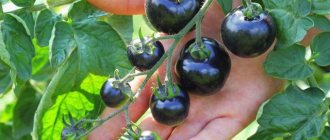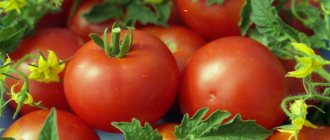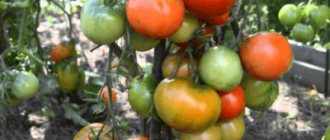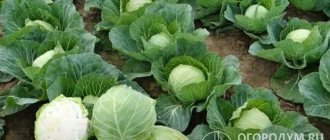Gardeners who have managed to appreciate all the advantages of Verlioka tomatoes should definitely try to grow a hybrid bred on its basis on their plot. The resulting variety has a number of significant advantages, unlike its predecessor. The fruit set is higher, their taste is richer, and it is also worth noting their unpretentiousness and better survival rate both under film and in an unheated greenhouse. Tomato Verlioka plus F1 will definitely appeal to those who prefer universal fruits with juicy pulp and a pleasant sweetish taste.
Tomato Verlioka plus bears fruit well when grown in greenhouse conditions, but also feels good in open ground
Description of the tomato variety Verlioka plus with photo
Tomato Verlioka plus F1, being a hybrid of the Verlioka variety (“Gisok-Agro”), has absorbed all the best from its predecessor. Russian breeders under the leadership of Sergei Fedorovich Gavrish worked on its creation. The variety was registered in the State Register in 2006. It is zoned in seven regions of Russia for cultivation in greenhouse conditions - these are the Northern and Northwestern regions, the Central, Central Black Earth, North Caucasus, as well as the Volga-Vyatka region and the Middle Volga region.
The Verlioka plus tomato can be described as determinate, but tall, reaching an average of 1 m in height. Under good conditions it can grow up to 1.5-1.8 m, which somewhat complicates the care process.
The bush is medium branched, with a moderate amount of green mass. The leaves are medium-sized, dark emerald in color with a standard tomato shape and smell. The inflorescence is of the classic type, racemose, the first is formed above the 8-9 leaf, the subsequent ones are formed with an interval of 1-2 leaves. Fruit set is high.
On the bush, the fruits are almost always equal in size and ripen together
Description of fruits
Fruits in a cluster can be formed up to ten pieces. They are quite large, their weight ranges from 100 to 140 g. The shape is flat-round, with weak ribbing at the base of the stalk.
When unripe, tomatoes have a light green hue; when technically ripe, they are bright red. The skin is thin, but dense enough to maintain the integrity of the fruit. When cut, the flesh is moderately juicy and sugary. The taste is pleasant, sweet, with a slight sourness.
Attention! The fruits of the Verlioka plus tomato can be collected from the bush in green form, as they are able to ripen quickly at room temperature.
Description and characteristics of the variety
Bush of determinate type, height 1.3-1.8 meters. Despite its early ripeness, the hybrid is recommended for cultivation in seasonal greenhouses and greenhouses. From germination to the first harvest you will have to wait 100-105 days. Tomato stems are significantly elongated, internodes are medium. The leaf is long, dark green in color, the leaf blades are sparsely spaced, their shape is similar to potato tops.
When they first met tomatoes, Europe perceived them as ornamental plants. At that time, tomato bushes could be seen in royal greenhouses and collections of noble people.
Inflorescences are of a simple type, formed through two leaves. Each brush forms from 5 to 7 ovaries. The lower fruits may be slightly larger than the upper ones, but on average the tomatoes are equal in size and shape. Verlioka plus f1 tomatoes are red, quite large - 120-140 grams each, round, even in shape, slightly ribbed at the top. The internal structure is four small chambers with seeds, the flesh is dense, pinkish-red.
Characteristics of tomato Verlioka plus
Considering in more detail the characteristics of the Verlioka Plus tomato variety, it is worth noting that it has many advantages compared to its predecessor. But this hybrid also has some features that can make it difficult to care for when growing.
Tomato yield Verlioka plus and fruiting
Tomato Verlioka plus is a mid-season variety, and about 100-105 days pass from the appearance of the first shoots to the technical maturity of the first fruits.
Fruiting is high when grown in greenhouse conditions; up to 4 kg can be harvested from a bush, and from 1 sq. m on average yields up to 10 kg of tomatoes. In open ground, the yield of the variety will be lower.
Attention! The content of sugars and dry substances in the fruits allows this variety to be used for baby and dietary nutrition.
Area of application of fruits
Verlioka plus tomato fruits are universal in application. They are uniform and medium in size, have a thick skin, which allows them to be preserved as a whole. Also, thanks to their pleasant taste, tomatoes are ideal for fresh consumption, making salads, cold and hot snacks, as well as for juice and tomato paste.
Resistance to diseases and pests
The Verlioka plus hybrid is highly resistant to many Solanaceae diseases, including late blight, fusarium, cladosporiosis and tobacco mosaic. But tomato resistance to pests is low. In greenhouse conditions, bushes can be attacked by insects such as spider mites, whiteflies, naked slugs and aphids.
Pros and cons of the variety
For early ripening tomatoes, the yield shown by Verlioka is considered high. Among the advantages of the variety it is also worth mentioning:
- disease resistance;
- transportability;
- versatility;
- attractiveness;
- good seed germination rates.
Disadvantages of the Verlioka variety:
- poor keeping quality;
- criticality to soil quality;
- the need to form a bush.
Tomatoes of this variety ripen at the same time. Those who keep a vegetable garden for personal needs will most likely consider this feature a disadvantage: it is necessary to quickly use a large volume, especially since the fruits are not stored for a long time. But for farmers cultivating tomatoes for sale, the ability to harvest a sufficient batch of vegetables at a time rather speaks in favor of the variety.
Overall, Verlioca is a good option for commercial cultivation. Bright, evenly colored tomatoes of equal size are attractive to buyers, do not crack or lose their presentation after transportation. But Verlioka tomatoes can only be harvested by hand; the berries are too tender for machine harvesting. The variety is more likely for small trade.
Verlioka tomatoes ripen quickly and efficiently at room temperature. If you have to transport it for more than two days, you need to harvest the crop without waiting for ripeness. The fruits will ripen on the way to the place of sale and will last longer.
Advantages and disadvantages
Like most hybrids, the Verlioka plus F1 variety has more advantages than its predecessor, but the plant is not without its drawbacks.
Harvested tomatoes, both at technical maturity and fully ripe, can be stored for a long time
pros
- tomato has good survival rate in greenhouse conditions and hotbeds;
- easily tolerates slight shading;
- shows good yield when formed into 2-3 stems;
- fruit set is high;
- has stable immunity to common diseases;
- the fruits are pleasant to the taste, smooth and almost all the same size;
- tomatoes are universal in use;
- suitable for long-term storage and transportation;
- When the fruits are picked in a green state, they quickly ripen at home.
Minuses
- demanding of soil, as they prefer light and nutritious soil with low acidity (6-6.5 pH);
- need to form a bush and tie it to stakes or trellises.
Growing in soil
The soil requirements in the greenhouse remain the same - the soil must be nutritious and airy. Verlioka tomatoes are sensitive to substrate deficiencies; you should not expect large yields on poor and heavy soil.
Verlioki bushes are planted at a distance of 40-50 cm from each other. You can fit 4 copies on one square meter. The plant cannot do without a garter, so you need to drive a support near each bush.
It is recommended to form a bush into one stem. The growth point should be transferred to a side shoot. To do this, you need to pinch the stem, leaving two leaves above the 3-4 inflorescence. A stepson is left under the upper inflorescence, from which further growth of the stem will continue.
Excess stepsons need to be removed regularly. Some gardeners advise picking off a pair of leaves located below the fruit every day from the beginning of ripening.
After transplantation, nitrogen fertilizing is given. Phosphorus will also be useful; it will help the plant quickly take root in a new place.
During the period of budding, flowering and formation of ovaries, tomatoes need to be fed with potassium and phosphorus, completely eliminating nitrogen.
Moderate watering is recommended, once every 5-7 days, depending on the speed of soil drying, with warm water.
Features of cultivation
Like many tomatoes, the Verlioka plus variety is best grown in seedlings. Seeds for planting should be purchased in a specialized store, be sure to pay attention to their expiration date, since material that has been stored for more than 2-3 years will have a low germination rate. The seeds do not need to be disinfected, but it is recommended to treat them with a growth stimulator 10-12 hours before.
Sowing of seed should begin between mid-March and early April. It is better to use ready-made, universal soil. It can be replaced with a mixture of garden soil with peat or humus, and disinfection must be carried out. To do this, the soil is calcined in the oven or watered with a weak solution of manganese.
The finished soil is distributed into a common container. The seeds are sown, deepening them no more than 1.5 cm, and sprinkled with wet sand on top. The container is covered with film or glass and placed in a warm, bright place. For germination, the ideal temperature is +25 ˚С; it is also important to ventilate the container at least twice a day, removing condensation.
After the first shoots appear, the shelter is removed and the seedlings are placed in diffused light, without direct sunlight. When 2-3 true leaves appear, the sprouts are picked and then transplanted into a single container. Afterwards, fertilizing is carried out with complex fertilizers. It is necessary to water the seedlings as the soil dries out in moderation, avoiding stagnation of water.
Transplantation of Verlioka Plus seedlings to a permanent place in the greenhouse is carried out approximately in mid-May. The soil is fertilized and loosened in advance, and immediately before planting, the holes are prepared by adding 1 tbsp. l. wood ash.
Recommended planting pattern: 35 cm between bushes and with a row spacing of 40 cm
Tomatoes in a greenhouse should be watered once every 5-6 days, and then be sure to ventilate them. Water must be used that is warm and settled. Tomatoes are fertilized at least three times per season with mineral complexes based on phosphorus and potassium. You can alternate them with organic matter.
Tomato Verlioka plus needs to form a bush, and it is best to do this in 2-3 stems. To do this, leave 2-3 lower, well-developed stepsons, and the rest are removed. The main stem is pinched. You can also form into one stem by removing the main trunk above 3-4 clusters, leaving instead a strong stepson with several leaves above it.
In addition to proper formation, the bushes also require garters. It is carried out when the plant is of average growth to the stakes, and it is recommended to fasten tall ones to trellises.
Sowing dates and seedling care
Verlioka tomatoes should be sown for seedlings 60-65 days before transplanting into the greenhouse.
Dates of sowing and planting depending on the region and type of shelter:
| climate zone | in film greenhouses | sowing time for seedlings | in a greenhouse made of polycarbonate or glass | sowing time for seedlings |
| south | May 5 – 27 | during March | April 25 – May 15 | February 20 – March 11 |
| middle lane | May 20 – June 01 | March 21 – 28 | May 10 – 20 | March 6 – 16 |
| north | May 25 – June 10 | March 21 – April 6 | May 15 – 30 | March 11 – 26 |
The soil for seedlings needs light and rich in nutrients. You can mix garden and turf soil, peat and well-rotted manure. For looseness, river sand is added to the mixture. The soil is disinfected by steaming, calcined in the oven or spilled with potassium permanganate.
Standard seedling care is required. The seeds are soaked in a growth stimulator, and after 24 hours they are sown, deepening them 1.5-2 cm into the soil. The container must be covered with cling film and kept at a temperature of +25°C.
After the shoots appear, the film should be removed and the container with the sprouts should be placed in the light. The temperature is lowered so that the seedlings temporarily slow down their growth and have time to get stronger. At the stage of the second leaflet, picking is carried out.
After transplanting, it is worth feeding the seedlings with an ash solution to stimulate root growth. Tomatoes should be watered with warm water, no more than once a week. Half a month before planting, the plants begin to harden.
You can transplant tomatoes into the greenhouse as soon as the soil warms up to +14... +16°C, and the night air temperature remains stably above zero.
Pest and disease control
Since the Verlioka plus variety is quite resistant to diseases, it will be enough to loosen the soil and remove weeds in a timely manner to prevent them. Plants are also fed to maintain immunity. To prevent the appearance of rot, it is important not to over-moisten the soil and frequently ventilate the greenhouse.
If tomato bushes are infected with late blight or fusarium, they are cleaned, removing the affected areas, and then treated with copper-containing preparations.
If aphids are infested, they are washed off the bushes with soapy water. And to get rid of winged pests and spider mites, insecticides are used.
Transplantation into open ground
Before planting, prepare the soil. Remove all weeds, loosen well and dig deep (up to 13 cm) holes. They are well watered with warm water and fertilized. Bushes are planted at intervals of 70 x 50 cm.
Tomatoes planted in open ground are protected from the bright sun. When the seedlings become stronger, the film can be removed. Bushes in a greenhouse will require frequent ventilation. They can get sick from excess moisture in the soil and air. Leaves, fruits and stems will begin to rot.
Plants are watered only with warm water. They are fed with both mineral and organic fertilizers. The first time this is done 2 weeks after planting the seedlings on a summer cottage. Then, every 10 days until flowering begins. After the ovaries appear, root feeding is carried out 2-3 times with mullein or bird droppings.
Tomato Verlioka: reviews from those who planted and grew the hybrid
Most opinions about this hybrid are positive, but there are features in growing the variety and some disadvantages that gardeners mentioned in their reviews of the Verlioka tomato.
Vera, 50 years old, Podolsk: I first planted this variety of tomato 4 seasons ago. The salesman in the store where I was choosing seeds for planting advised me to plant it. In the first season, I did not form bushes, so the tomatoes grew small and the yield was not very good. But the next season I already formed this tomato into two shoots, as a result, I collected 5 kg of ripe fruit or so from each bush. We had enough for food, and we also put it in jars. I plant it every year now.
Olya, 44 years old, Voronezh region: This year I planted the Verlioku tomato for the first time. The yield was good, but the fruits were too watery. I probably watered too often. Next season I will try to water no more than 2 times a week.
Tatyana, 39 years old, Barnaul: Every year in my greenhouse I leave a couple of beds for a new variety of tomatoes. Several years ago I planted the Verlioku hybrid and did not regret it. The fruits are sweet and sour, good in salads, and for the winter they were covered with ketchup and pickled. My family ate everything without a trace even before the New Year. In the future, I planted more bushes of this variety so that there would be enough twists until spring.
One of the best early-ripening tomatoes in terms of yield is Verlioka. Its delicious fruits can be used to prepare vegetable salads or various snacks, pickled or salted, and preserve various salads with this tomato for the winter.
The undemanding and unpretentiousness of the hybrid makes it attractive to beginner vegetable growers, who will not have any difficulty growing Verlioka in their garden.
Recently searched:
Features of care
Planted in a greenhouse or under film, tomatoes require abundant watering: 5 liters per bush. Mulching the soil will help avoid overheating and rapid evaporation of moisture. The humidity level must be controlled and a uniform temperature regime must be maintained, which will protect the plants from late blight. Ambient air humidity is ensured within 60%, soil cover - 70–80%.
The optimal time for watering is considered to be evening hours. You need to use warm water. Modern gardeners often use a drip irrigation system, which allows them to provide dosed watering and the application of liquid fertilizers to their tomatoes.
Verlioka f1 is a hybrid variety that requires timely pinching in order to form one stem and two shoots, each of which leaves 1–2 inflorescences. This will accelerate the development of the plant, increase fruitfulness and improve the quality of the fruit. After the inflorescences there should be two leaves. Tying is an indispensable condition for growing tomatoes of this variety.
Tomatoes are fed with mineral fertilizers (potassium salt, superphosphate), alternating with organic matter (mullein, liquid droppings). Number of feedings: 3–4 per season.
Harvest and storage
The description of the Verlioka variety confirms its universal purpose due to the quality and taste characteristics of the fruit. Juicy tomatoes of moderate sweetness are consumed fresh, as a component of vegetable salads and winter preparations. Identical tomatoes are good canned and look beautiful in a jar. The density of the peel does not allow the fruits to burst when pouring boiling water.
Thanks to the juicy pulp, almost without voids, the Verlioka fruits make excellent preparations:
- tomato paste;
- ketchup;
- juice;
- puree;
- sauces.
The delicate taste and pleasant aroma of Verlioka is preserved during cooking, so tomatoes are suitable as an ingredient in first courses, gravy, vegetable stews, and stuffed vegetables. Freezing of tomatoes cut into circles or cubes is allowed.
Growing the Verlioka variety allows housewives to use fresh or canned tomatoes in summer and winter.
Planting tomatoes of this variety can be done by experienced gardeners and beginners, whose efforts will pay off with a rich harvest of tasty and aromatic fruits.
Transplanting Verlioka tomato seedlings to a permanent place of growth
Greenhouses are prepared for planting tomato seedlings in advance - the structures are disinfected, the top layer of soil is replaced with fresh, nutritious and loose soil.
On each square of the greenhouse area, no more than 4 Verlioka tomato seedlings can be planted. Planting is done in pre-prepared holes, covered with a layer of soil on top and watered.











